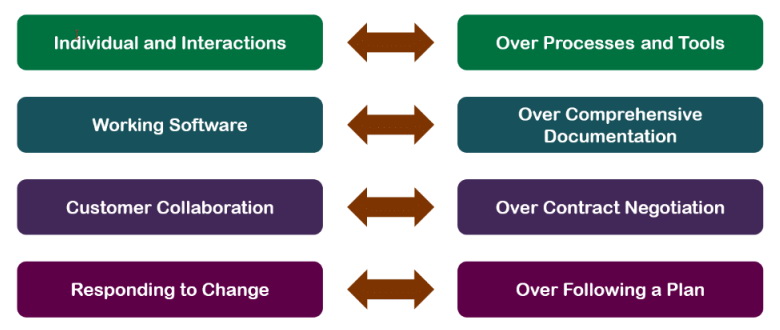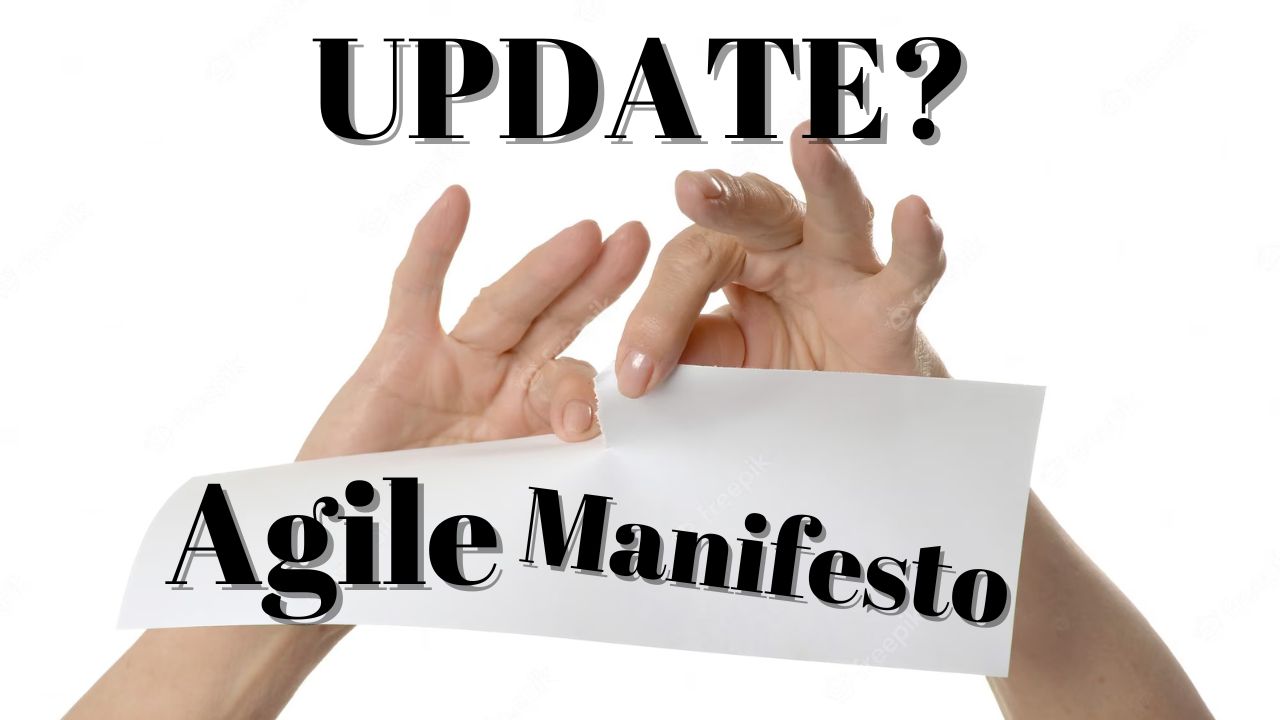The Survival Agile Manifesto 2023 Update!
In February 2001, 17 software development luminaries authored the Agile Manifesto. This seminal document codified 4 core values and 12 principles that pioneered an adaptive approach to building technology, disrupting decades of entrenched waterfall processes.
Over 20 years later, the lightweight essence of Agile still holds. But with seismic shifts in systems, business models, and culture, are the specifics of the original manifesto due for a refresh? Is it time for the Agile Manifesto 2023 Update?
Feel free to download the original Agile Manifesto and see for yourself.
In this article, we will reflect on:
- The Origins and Historical Impact of the Agile Manifesto,
- The case for revisiting such an influential document today (Agile Manifesto 2023 Update),
- Proposed updates to the values and principles that aim to retain the timeless spirit while adapting for the modern era,
- Key takeaways and a call-to-action for the community to continue shaping the future of Agile.
Let’s get started with The Survival Agile Manifesto 2023 Update!
Introduction to Agile Manifesto 2023 Update
The Agile Manifesto. For software developers, these three words need no introduction. This revolutionary document, crafted in 2001 by industry legends, formalized values and principles that changed the world of software development forever.
Before the Agile Manifesto, software teams rigidly followed waterfall processes and heavy documentation. But the manifesto dared to ask – could there be a better way?
Should we even consider The Agile Manifesto 2023 Update?
The answer was a resounding YES!
Agile introduced concepts that seemed radical at the time: delivering working software frequently, collaborating with customers, and embracing change. This lightweight and adaptive approach resonated with developers weary of bureaucracy and silos.
The Agile philosophy spawned frameworks like Scrum and Kanban. It enabled faster innovation cycles and unlocked agility at established enterprises. Over 20 years later, Agile is the new normal.
But today’s software landscape would be nearly unrecognizable to the original signatories of the Agile Manifesto. As technology and businesses evolve at an exponential pace, is it time to re-examine the Agile values for the modern era?
The esteemed authors crafted an impactful manifesto in 2001. Yet the specifics may no longer perfectly fit today’s environment in 2023.
What Agile Manifesto 2023 Update could bring Agile principles to the next level?
How can we build upon this foundation while retaining its essence?
Is it time to revisit these seminal Agile Values, 20 years later in the Agile Manifesto 2023 Update?

The Origins of the Agile Manifesto
In February 2001, 17 seasoned software developers gathered amid the snow-capped mountains of Utah.
This was no ordinary meeting – the location was the Snowbird Resort, and the goal was ambitious: to fundamentally transform software development.
The gathered experts included:
- Kent Beck, creator of extreme programming
- Ward Cunningham, inventor of wikis
- Martin Fowler, a seminal author on patterns and refactoring
- Dave Thomas, founder of OTI and mentor to a generation of developers
- and over a dozen more pioneers and influencers
These industry legends had seen the shortcomings of traditional software practices like heavyweight processes, documentation-driven development, and rigid planning.
They knew there had to be a better way
During this legendary summit, they distilled their collective experiences into 4 core values and 12 principles – the Agile Manifesto. It formalized an adaptive, lightweight approach centered on collaboration and delivering value.
This manifesto represented a dramatic departure from entrenched waterfall development. Out were big upfront requirements and static plans. In were short iterations, frequent feedback, and motivating individuals over enforcing processes.
When published, the Agile Manifesto resonated with developers weary of bureaucracy and dysfunction. It spawned frameworks like Scrum and Kanban, which translated the values into practices for teams. The manifesto sparked a movement that transformed not just software development, but how businesses innovate.
The Need for Agile Manifesto 2023 Update
In the 22 years since the Agile Manifesto was penned, the software landscape has changed dramatically. When the manifesto was written, the dot com boom was collapsing.
Today, software eats the world.
Examples of how development has changed since 2001
- In 2001, waterfall development was still common. Today, agile is the norm.
- Most apps were monolithic. Microservices and distributed systems now prevail.
- Developers relied on heavyweight requirements docs.
- Today, user stories and constant client feedback drive development.
- Testing often happened late in development. Now test-driven development is the best practice.
- The software was developed in long release cycles. The norm is now continuous delivery and DevOps practices.
- Apps were built for desktops only. Now, apps are omnichannel, mobile-first, and web-scale.
- Open source was niche. Today, it dominates with libraries like React and frameworks like Node.js.
- Big data, AI/ML, IoT, and blockchain did not exist. Now they are transforming development.
In the face of massive technology and business model shifts, core Agile values endure but the specifics warrant re-examination.
The pace of technological innovation continues to accelerate exponentially.
Businesses now operate in a climate of constant disruption and uncertainty. Systems are increasingly complex, interconnected, and global.
Meanwhile, customer expectations for delightful digital experiences have skyrocketed. Users demand instant gratification – bug-free updates continuously.
Emerging technologies like artificial intelligence, blockchain, and quantum computing open up new possibilities that could not have been imagined in 2001. The way we develop software today looks very different than two decades ago.
In light of these seismic shifts, is the Agile Manifesto due for a refresh?
The original authors could not have predicted the speed of change to come. The foundational values are timeless, but specifics like “working software over documentation” sound dated today.
Rather than rewrite history, the spirit of the original can be honored while updating the principles. The next generation of developers can stand on the shoulders of giants to take Agile to the next level.
The conversation continues as we collectively shape what’s next for building great software.
But what would they say today in 2023?
The original Agile Manifesto contained 4 core values. But given how much has changed in the past 22 years, I believe it may be time to expand this foundation in the Agile Manifesto 2023 Update.
Here is my perspective on updating the values; I am suggesting 6 Agile Manifesto 2023 Update Values instead of 4, and in the following sections, I will elaborate on each of them in more detail.
- Customer-centricity over processes and tools
- Working software and actionable insights over comprehensive documentation
- Stakeholder collaboration over contract negotiation
- Embracing change and uncertainty over following a fixed plan
- Diversity, equity, and Inclusion over hierarchical Teams
- Sustainability over short-term delivery
While the original 4 values are still fundamental, the additional focus today should be on adaptable mindsets, delivering lasting value, and responsible development.
Let’s explore each Agile Manifesto 2023 Update Value in more detail
- Customer-centricity over processes and tools:
Putting the customer at the center of everything you do. This means deeply understanding user needs through research, feedback, and insights before designing solutions. For example, app developers launching a new feature would first engage target users to identify pain points and design the functionality accordingly, rather than just follow their internal roadmap. - Working software and actionable insights over comprehensive documentation:
Focusing on continuously delivering working software that provides value to users. But also leveraging experimentation and usage data to gain actionable insights to guide development. For example, a team might A/B test new features and analyze usage metrics to determine what resonates most with users. - Stakeholder collaboration over contract negotiation:
Engaging diverse stakeholders early and continuously collaborating with them beyond just customers. For example, collaborating with compliance and legal partners to clear new product directions, not just negotiating contracts after the fact. Or collaborating with infrastructure teams to deliver solutions compatibly. - Embracing change and uncertainty over following a fixed plan:
Being adaptive and nimble, versus trying to predict and rigidly adhere to a detailed long-term plan. For example, reassessing priorities and timelines every few weeks versus committing to a multi-year roadmap. Or being open to changing technical direction as innovations emerge. - Diversity, equity, and Inclusion over hierarchical Teams:
Fostering teams where everyone feels psychologically safe to contribute. Providing equal opportunities for people from different backgrounds. For example, ensuring team members strategies like pair programming rather than siloed work. And promoting policies to eliminate discrimination. - Sustainability over short-term delivery:
Building solutions in a responsible way for the long haul. For example, balancing delivery velocity with technical debt paydown. Or considering the environmental impact of technology choices. And providing good work-life balance and learning opportunities for staff retention.
The Future of Agile Manifesto
While the 4 core values are the focus of this post, the 12 principles of the Agile Manifesto also warrant a fresh look. But we will table that conversation for another day.
This thinking aims to re-examine the essence of the Agile philosophy through its central values. The principles translate those values into practice and are ripe for an updated perspective in the future.
The software landscape will surely continue to evolve. But the spirit of the Agile Manifesto should live on – collaboration, customer focus, and embracing change. Updating the specific values allows Agile practices to flex and adapt just as Agile intended.
What do you think of these proposed Agile Manifesto 2023 Update Values?
How would you update the manifesto for today’s software development world?
The conversation continues as we collectively shape the future of building software.
Conclusion
The Agile Manifesto upended decades of entrenched software development practices and ushered in a new era of adaptive, lightweight methodologies. But even seminal documents occasionally require a refresh.
After 20+ years of exponential technology change, updating the specifics allows the timeless Agile values to be translated for modern development realities. As an industry, we stand on the shoulders of giants like Beck, Cunningham, and Fowler who pioneered this movement.
This proposed Agile Manifesto 2023 Update is offered humbly in that pioneering spirit. By expanding the values to address inclusion, sustainability, and constant change, the aim is to spark continued conversation.
The future of Agile remains a collaborative effort. Readers are encouraged to share feedback on these ideas and also check out “The Real Scrum Guide 2023″ – for fully updated Agile principles.
By honoring the original manifesto while evolving its principles, we can collectively shape the next 20 years of building software and delivering value. The Agile conversation continues, and you can help write the next chapter by sharing your perspective.
Explore our Scrum Blog, join our community, and together, let’s foster continuous improvement in our pursuit of excellence.
